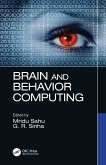Brain-Computer Interfaces Handbook
Technological and Theoretical Advances
Herausgeber: Nam, Chang S; Lotte, Fabien; Nijholt, Anton
Brain-Computer Interfaces Handbook
Technological and Theoretical Advances
Herausgeber: Nam, Chang S; Lotte, Fabien; Nijholt, Anton
- Broschiertes Buch
- Merkliste
- Auf die Merkliste
- Bewerten Bewerten
- Teilen
- Produkt teilen
- Produkterinnerung
- Produkterinnerung
This handbook addresses the recent and rapid changes in the field of braincomputer interfaces (BCIs). Due to these changes interest in BCI has grown enormously, including interest from computer science researchers with a background in computational intelligence, human-computer interaction, and researchers in entertainment technology.
Andere Kunden interessierten sich auch für
![Brain and Behavior Computing Brain and Behavior Computing]() Brain and Behavior Computing77,99 €
Brain and Behavior Computing77,99 €![Intelligent Infrastructure Intelligent Infrastructure]() Nastaran DadashiIntelligent Infrastructure59,99 €
Nastaran DadashiIntelligent Infrastructure59,99 €![BIM-enabled Cognitive Computing for Smart Built Environment BIM-enabled Cognitive Computing for Smart Built Environment]() BIM-enabled Cognitive Computing for Smart Built Environment68,99 €
BIM-enabled Cognitive Computing for Smart Built Environment68,99 €![Developing Performance Support for Computer Systems Developing Performance Support for Computer Systems]() James R WilliamsDeveloping Performance Support for Computer Systems82,99 €
James R WilliamsDeveloping Performance Support for Computer Systems82,99 €![Applied Attention Theory Applied Attention Theory]() Christopher D WickensApplied Attention Theory60,99 €
Christopher D WickensApplied Attention Theory60,99 €![AI Knowledge Transfer from the University to Society AI Knowledge Transfer from the University to Society]() AI Knowledge Transfer from the University to Society25,99 €
AI Knowledge Transfer from the University to Society25,99 €![Biomechanics of the Upper Limbs Biomechanics of the Upper Limbs]() Andris FreivaldsBiomechanics of the Upper Limbs75,99 €
Andris FreivaldsBiomechanics of the Upper Limbs75,99 €-
-
-
This handbook addresses the recent and rapid changes in the field of braincomputer interfaces (BCIs). Due to these changes interest in BCI has grown enormously, including interest from computer science researchers with a background in computational intelligence, human-computer interaction, and researchers in entertainment technology.
Produktdetails
- Produktdetails
- Verlag: Taylor & Francis Ltd (Sales)
- Seitenzahl: 816
- Erscheinungstermin: 19. August 2019
- Englisch
- Abmessung: 251mm x 178mm x 41mm
- Gewicht: 1610g
- ISBN-13: 9780367375454
- ISBN-10: 0367375451
- Artikelnr.: 57537518
- Herstellerkennzeichnung
- Libri GmbH
- Europaallee 1
- 36244 Bad Hersfeld
- gpsr@libri.de
- Verlag: Taylor & Francis Ltd (Sales)
- Seitenzahl: 816
- Erscheinungstermin: 19. August 2019
- Englisch
- Abmessung: 251mm x 178mm x 41mm
- Gewicht: 1610g
- ISBN-13: 9780367375454
- ISBN-10: 0367375451
- Artikelnr.: 57537518
- Herstellerkennzeichnung
- Libri GmbH
- Europaallee 1
- 36244 Bad Hersfeld
- gpsr@libri.de
Chang S. Nam is an associate professor of Edward P. Fitts Industrial and Systems Engineering at North Carolina State University, USA. He is also an associated professor of the UNC/NCSU Joint Department of Biomedical Engineering as well as Department of Psychology. He received a PhD from the Grado Department of Industrial and Systems Engineering at Virginia Tech in 2003. Dr. Nam is the author or coauthor of over 70 research publications including journal articles, books, book chapters, and conference proceedings. Dr. Nam's research interests center around brain-computer interface and rehabilitation, wearable sensor-based remote healthcare, neuroergonomics, neuroadaptive automation in large-scale unmanned aerial vehicles (UAVs), and haptic-user interaction. His research has been supported by federal agencies including National Science Foundation (NSF), Air Force Research Laboratory (AFRL) and National Security Agency (NSA). Dr. Nam has received the NSF CAREER Award, Outstanding Researcher Award, and Best Teacher Award. Currently, Dr. Nam serves as the Editor-in-Chief of the journal Brain-Computer Interfaces. Anton Nijholt is Professor Emeritus of the University of Twente, the Netherlands and research-fellow at the Imagineering Institute in Iskandar, Malaysia. He studied mathematics at Delft University of Technology and received a PhD in computer science from the Vrije Universiteit, Amsterdam. He held positions at McMaster University, Canada, University of Twente, Nijmegen University and Vrije Universiteit Brussels, before becoming full professor at the University of Twente, where he established the Human Media Interaction (HMI) research group. He supervised more than fifty PhD students in natural language processing, human-computer interaction, multi-party interaction, and brain-computer interfacing. His research has been supported by regional, national and EU research agencies. Nijholt is author of hundreds of research papers and he is editor of books on brain-computer interfaces, entertainment computing, playful interfaces and playable cities. Nijholt was research-fellow at the Netherlands Institute for Advanced Study in the Humanities and Social Sciences (NIAS) and for several years he acted as an adviser for Philips Research. Nijholt also acted as general or program chair of all main international conferences on entertainment computing, virtual agents, affective computing and multimodal interaction. Currently he is editor of the Springer book series on Gaming Media and Social Effects, specialty chief Human-Media Interaction of the journal Frontiers in Psychology and member of editorial boards of various other journals. Fabien Lotte is a Research Scientist (with tenure) at Inria Bordeaux Sud-Ouest, France, since 2011. He obtained a M.Sc., a M.Eng. and a PhD degree in computer sciences, all from the National Institute of Applied Sciences (INSA) Rennes, France, in 2005 (M.Sc., M.Eng.) and 2008 (PhD). In 2009 and 2010, he was a research fellow at the Institute for Infocomm Research (I2R) in Singapore, working in the Brain-Computer Interface Laboratory. His research interests include Brain-Computer Interfaces (BCI), human-computer interaction, pattern recognition and brain signal processing. He is the author or co-author of about 100 publications, several of which published in the best journals (e.g., Journal of Neural Engineering, IEEE Transactions on Biomedical Engineering, Proceedings of the IEEE, IEEE Transactions on Signal Processing, etc.) and conferences (ICASSP, UIST, CHI, etc.) in these fields. His PhD Thesis received both the PhD Thesis award 2009 from AFRIF (French Association for Pattern Recognition) and the PhD Thesis award 2009 accessit (2nd prize) from ASTI (French Association for Information Sciences and Technologies). His research is supported among others by Inria, the French National Research Agency (ANR) and the European Research Council (ERC). He is part of the editorial boards of the journals Brain-Computer Interfaces and Journal of Neural Engineering.
Introduction. Part I: Brain-Computer Interface Applications. Section A:
Brain-Computer Interfaces Introduction. Section B: Therapeutic
Applications. Section C: Affective and Artistic Brain-Computer Interfaces.
Section D: BCI Control of Entertainment and Multimedia. Part II: Signal
Acquisition and Open Source Platform in BCI. Part III: Signal Processing,
Feature Extraction, and Classification in BCI. Part IV: Brain-Computer
Interface Paradigms. Part V: Human Factors, Design, and Evaluation in BCI.
Part VI: Emerging Issues and Future BCIs. Conclusion: Moving Forward in
Brain-Computer Interfaces.
Brain-Computer Interfaces Introduction. Section B: Therapeutic
Applications. Section C: Affective and Artistic Brain-Computer Interfaces.
Section D: BCI Control of Entertainment and Multimedia. Part II: Signal
Acquisition and Open Source Platform in BCI. Part III: Signal Processing,
Feature Extraction, and Classification in BCI. Part IV: Brain-Computer
Interface Paradigms. Part V: Human Factors, Design, and Evaluation in BCI.
Part VI: Emerging Issues and Future BCIs. Conclusion: Moving Forward in
Brain-Computer Interfaces.
Introduction. Part I: Brain-Computer Interface Applications. Section A:
Brain-Computer Interfaces Introduction. Section B: Therapeutic
Applications. Section C: Affective and Artistic Brain-Computer Interfaces.
Section D: BCI Control of Entertainment and Multimedia. Part II: Signal
Acquisition and Open Source Platform in BCI. Part III: Signal Processing,
Feature Extraction, and Classification in BCI. Part IV: Brain-Computer
Interface Paradigms. Part V: Human Factors, Design, and Evaluation in BCI.
Part VI: Emerging Issues and Future BCIs. Conclusion: Moving Forward in
Brain-Computer Interfaces.
Brain-Computer Interfaces Introduction. Section B: Therapeutic
Applications. Section C: Affective and Artistic Brain-Computer Interfaces.
Section D: BCI Control of Entertainment and Multimedia. Part II: Signal
Acquisition and Open Source Platform in BCI. Part III: Signal Processing,
Feature Extraction, and Classification in BCI. Part IV: Brain-Computer
Interface Paradigms. Part V: Human Factors, Design, and Evaluation in BCI.
Part VI: Emerging Issues and Future BCIs. Conclusion: Moving Forward in
Brain-Computer Interfaces.









